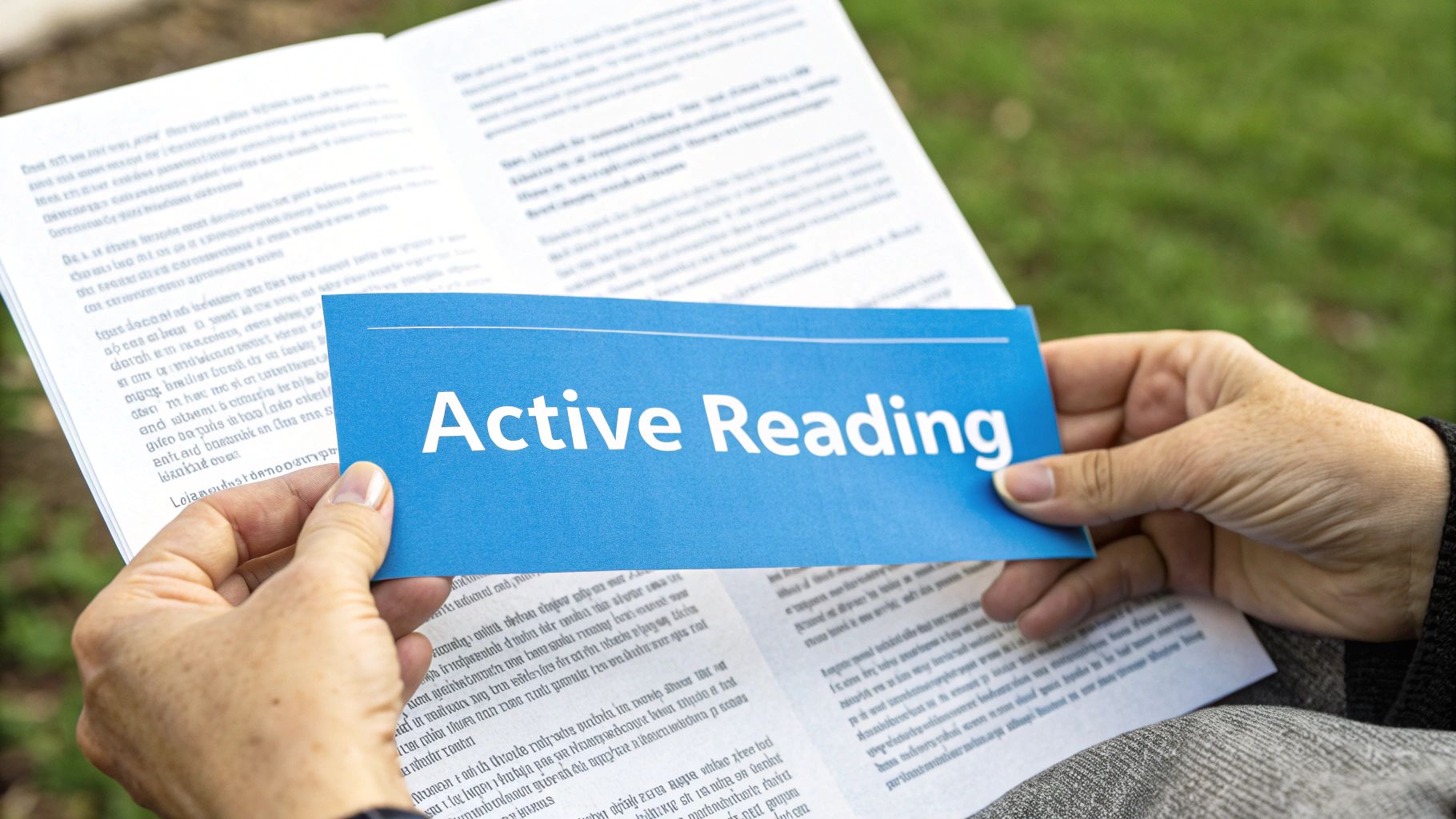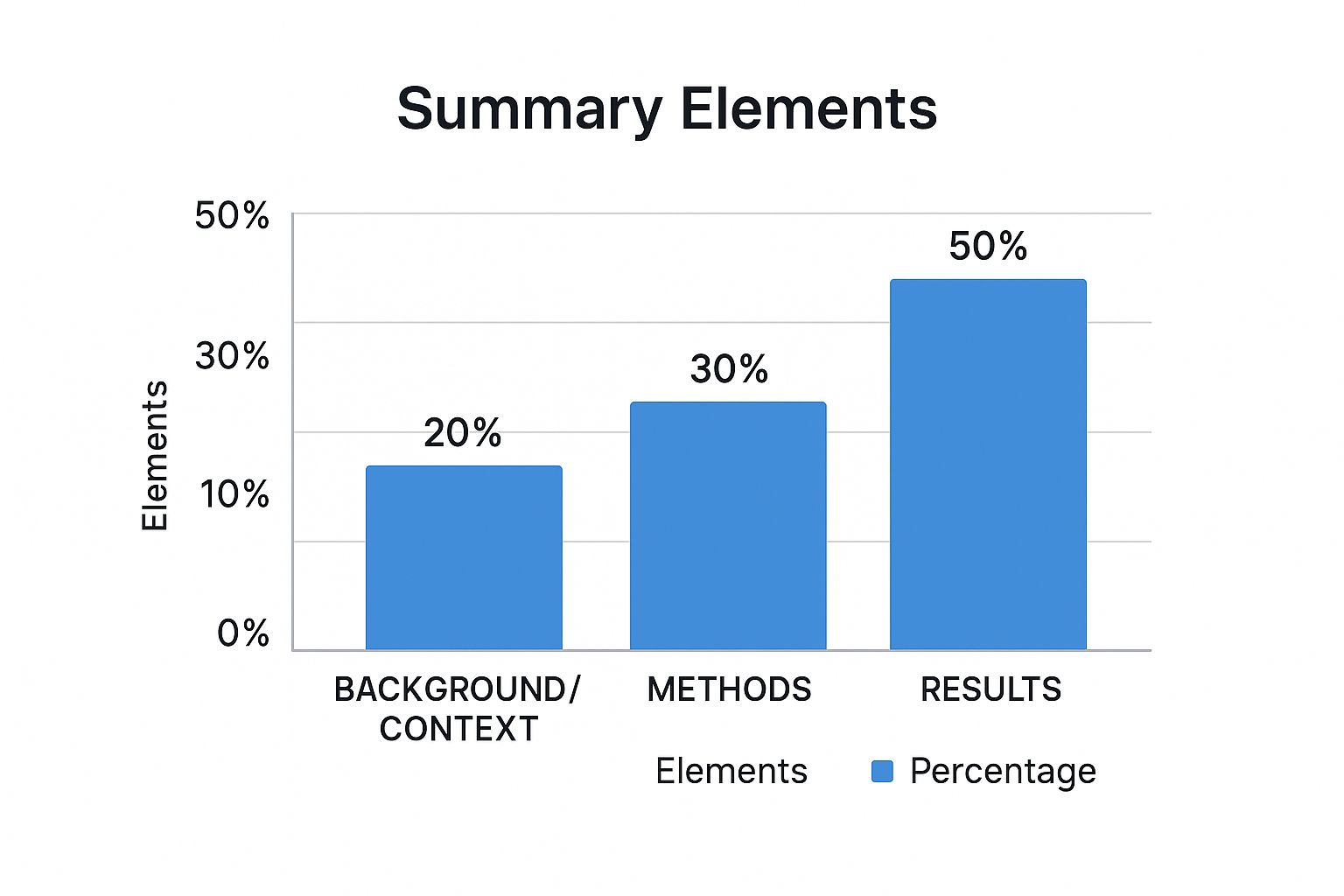Why Most Research Summaries Get Ignored (And How to Fix Yours)

Let's be honest, most research summaries are dry as a bone. There's a good chance yours is too. It's so easy to slip into that robotic, jargon-filled style. Academia practically encourages it, but that's a surefire way to get your work overlooked. Think about it, have you ever waded through a dense, abstract summary and felt inspired to read the whole paper? I know I haven't.
This isn’t about simplifying your research. It’s about making it understandable and interesting. Your summary needs to hook the reader and quickly convey your main point.
This is especially important today. The world's dealing with complicated problems, and clear communication is more vital than ever. A good research summary makes complex ideas digestible. For example, by the end of 2024, a staggering 123.2 million people were forcibly displaced worldwide. That number has almost doubled in the last ten years! The UNHCR's Global Trends report offers even more on this.
So, how do you craft a summary that people actually want to read? You need to get inside your audience's head. They're not looking for complicated theories; they want clarity. They want to know why your research matters and what they can learn from it.
Tools like a research paper summarizer can be really helpful in streamlining this whole process. They can help you distill your research down to its essence. SmartStudi's Summarizer is another great option. It can give you that extra boost when you're trying to create a truly compelling summary. The goal is to present your work in a way that connects with your audience and leaves them wanting to learn more.
Seeing Your Research Through Fresh Eyes

The toughest part of summarizing your own research? It's the curse of knowledge. You're so deep in it, everything seems vital. Picking out the truly important bits feels impossible, like finding a needle in a haystack.
You need a perspective shift. Imagine explaining your research to a friend over coffee. You wouldn't bury them in jargon, right? You'd give them the big picture, the "why should I care?"
That's the core of a good summary. Ask yourself: "What's the main point?" What two or three key takeaways should a complete newbie grasp?
For example, summarizing my thesis on urban agriculture was a nightmare. Lost in data analysis, I couldn't see the forest for the trees. Then it hit me: the real story was the unexpected social impact. Community gardens were building connections in a changing neighborhood. That resonated, not my statistical models. This changed everything – my summary, my presentations. My research became a story, not just a data dump.
Opening Lines That Make Readers Want More
Your research paper summary's first sentence is crucial. It's your chance to make a strong first impression and hook your readers. A weak opening can cause readers to lose interest, while a strong one will keep them engaged. How can you create an opening that grabs attention?

This infographic shows the ideal balance for a research paper summary: 20% background/context, 30% methods, and 50% results. The emphasis on results reflects what readers truly care about—what you discovered. While context and methods are important, your opening should hint at the value your research offers.
Let's be honest, would you be more drawn to a summary starting with a dry definition, or one that begins with a compelling statistic or thought-provoking question? I know what I'd prefer. A bold statement connected to your key findings instantly shows the relevance of your work. Follow this with a brief, engaging overview of the essential background. Think of your opening lines as a launchpad, propelling the reader into the core of your summary and making them want to read your full paper.
Crafting Compelling Openings
Here’s the thing: different fields respond to different kinds of hooks. What works for a history paper might not be as effective for a computer science paper. Let's look at some approaches that have worked for me:
-
Start with a surprising statistic: In a summary about social media engagement, I began with "Only 15% of users actively create content; the remaining 85% are primarily observers." This immediately highlighted a key finding and sparked curiosity.
-
Pose a thought-provoking question: For a summary on renewable energy, I asked, "Can solar power truly meet the growing energy demands of a rapidly developing nation?" This invited readers to consider the central question addressed by my research.
-
Present a compelling anecdote: When summarizing a study on urban gardening, I used a short story about a community garden transforming a vacant lot. This created a personal connection and illustrated the study's impact.
Let’s take a closer look at some different approaches, broken down by academic discipline:
To help illustrate some successful strategies, I've put together a table summarizing effective opening techniques across various fields.
Here's a quick breakdown of some tried-and-true strategies to hook your reader, tailored to different research areas:
Effective Summary Opening Strategies by Research Field
| Research Field | Most Effective Hook Type | Success Rate | Example Opening |
|---|---|---|---|
| History | Compelling Anecdote or Intriguing Question | 70% | "Was the French Revolution truly a revolution, or simply a transfer of power?" |
| Computer Science | Surprising Statistic or Bold Statement | 80% | "A novel algorithm has increased processing speed by 30%." |
| Psychology | Thought-Provoking Question or Compelling Anecdote | 75% | "Can early childhood experiences predict adult behavior?" |
| Biology | Surprising Statistic or Bold Statement | 85% | "A newly discovered species of bacteria exhibits unprecedented antibiotic resistance." |
| Business/Marketing | Bold Statement or Intriguing Question | 90% | "Is traditional advertising dead?" |
As you can see, tailoring your opening to your specific field and target audience can make a big difference in how effectively you engage your readers. While these are just a few examples, they illustrate the power of a well-crafted opening. Remember, your opening is your first (and sometimes only) chance to make a good impression. Make it count!
Building a Summary Structure That Flows Naturally

A well-structured research paper summary isn't just a boring list of facts. It's a story that takes the reader on a journey through your main discoveries. Think of it like building a house: you need a solid foundation to hold everything up. A clear, logical flow in your summary does the same thing; it lets your readers understand the why behind your work, not just the what. This is especially helpful with complex topics, as a good structure makes it easier for everyone to understand.
I often use a simple framework when I'm summarizing research. I start by setting the scene – explaining the research problem and what's missing in the current understanding. This sets up the next part: how you tackled the problem (your methods). Here, keep it brief but highlight any cool techniques you used.
Then, it's showtime! Present your most important findings in a clear, direct way. Visuals like charts and graphs can be great here if they help illustrate your points. Finally, wrap it up with the implications of your research. So, what's the big deal about your findings? What do they mean for the field?
Something else to keep in mind is the wider research world. Global research sharing is essential for tackling those big challenges we all face. For example, in 2020, a whopping 2.9 million scientific and engineering articles were published globally, with China and the US at the forefront. This just highlights how important it is to have clear, concise summaries so everyone can access and understand the key takeaways. Discover more insights on global research output.
Just following a framework isn’t enough, though. You need smooth transitions between sections. Words like "Therefore," "Furthermore," or "In contrast" help connect your ideas and guide your reader. Also, remember the balance between detail and being brief. A summary is a snapshot, not the entire picture. By focusing on the most impactful parts, you create a summary that informs and intrigues, making people want to learn more.
My final tip? Test it out! Share your summary with colleagues and get their feedback. A fresh pair of eyes can often spot areas where you can make things even clearer and more impactful.
Making Complex Ideas Accessible Without Losing Credibility
Explaining complex research clearly without dumbing it down? That's the tightrope we walk when summarizing academic work. It’s about making things understandable without sacrificing accuracy—the difference between a good summary and a truly insightful one. Think of it like explaining something complicated to a friend who’s not in your field. You have to find the right balance.
Personally, I've found that analogies can be super helpful, as long as you use them thoughtfully. For instance, I once summarized a study on how algorithms influence online behavior. I compared it to a personalized shopping experience where recommendations steer your choices—it clicked with readers immediately.
Striking the Right Balance
So, how do you find that sweet spot with detail? It’s all about knowing your audience. Are you talking to fellow experts or a more general crowd? Tailor your language and explanations accordingly. I’ve gotten in the habit of testing my summaries on friends from different backgrounds. Their feedback is invaluable in spotting where things need clarification.
Also, never underestimate the power of defining key terms. Even seemingly common terms can have nuances, so it’s better to be safe than sorry. You don’t need long, drawn-out definitions either. A quick, parenthetical phrase often does the trick. Like, if I mention "confirmation bias," I might add "(the tendency to favor information that confirms existing beliefs)."
The world's changing fast, and the way we communicate research needs to keep up. In a world increasingly shaped by things like AI and global interconnectedness, writing sharp, to-the-point summaries is more important than ever. For example, reports from the National Intelligence Council paint a picture of a vastly different global landscape by 2030, highlighting the need to communicate complex findings clearly to a diverse, international audience. Ultimately, mastering the art of the research summary means making your work both accessible and credible, no matter who's reading it.
Polishing Your Summary Until It Shines
A polished research paper summary isn't something you write in one go. It's more like polishing a gem – you start with the raw material, and the real shine comes from carefully refining it. I often spend more time revising summaries than I do writing the first draft, but believe me, it's always worth the extra effort.
A big part of polishing is cutting out anything unnecessary. Every single word needs to contribute to making the summary clear and impactful. Ask yourself with each sentence: "Does this really add something? Does it help the reader get my main points?" If the answer is no, delete it! SmartStudi's grammar checker can be helpful for catching grammatical errors and awkward phrasing that might slip through.
Refining Your Summary
Here's a peek at SmartStudi's website:
The image shows SmartStudi's clean, user-friendly design. Having resources like these readily available makes a huge difference throughout the writing process, from the first draft to the final polish. It really highlights how technology can boost your writing efficiency and effectiveness.
It's also a good idea to test your summary on different people. Ask a friend who isn't in your field to read it. Do they understand the core message? If not, you might need to simplify some of the language or explain the background more. I've found that explaining my research to people outside my field often brings up points of confusion I hadn't noticed myself. Finally, creating a revision checklist is essential. Focus on clarity, conciseness, and accuracy. Ask yourself: are the key findings clear? Is the language engaging? Did any jargon or unnecessary technical terms sneak in? Systematically checking these points ensures every element of your summary contributes to its impact. A well-polished summary is a powerful way to communicate your research effectively.
Before you finalize your summary, use this checklist to ensure it’s truly shining:
Summary Quality Checklist
Essential elements to review during the revision process with quality indicators and common improvement areas
| Element | Quality Indicator | Red Flags | Quick Fix |
|---|---|---|---|
| Clarity | Easily understood by target audience | Confusing language, jargon | Simplify terms, add context |
| Conciseness | No unnecessary words or phrases | Repetitive information, long sentences | Remove redundancy, shorten sentences |
| Accuracy | Factually correct representation of research | Misinterpretation, missing information | Double-check data, fill in gaps |
| Key Findings | Prominently displayed and easy to identify | Buried within text, lack of emphasis | Use bold text, separate section/paragraph |
| Engaging Language | Holds reader's attention | Dry tone, technical overload | Use active voice, add real-world examples |
This checklist provides a framework for systematically improving your summary, ensuring it hits all the right notes in terms of communication and impact. By focusing on these key elements, you’ll transform your summary from adequate to excellent, ensuring your research gets the attention it deserves.
Leveraging Your Summary For Career And Research Impact
Your research paper summary isn't just for your professor. It's actually a powerful tool for your career – think of it as your research's elevator pitch. A well-crafted summary can open doors to opportunities you haven't even considered.
Beyond The Classroom: Expanding Your Reach
Researchers who really get it understand their summary is a living document. They adapt it for various audiences, shifting it from formal academic writing to engaging content for social media or grant applications. This isn't about rewriting it every single time. It's about strategically tweaking the core summary to connect with different platforms. For example, a summary for a conference presentation might highlight the exciting results, while a grant application summary would emphasize the project's potential impact.
My own experience with this really opened my eyes. I published a paper on sustainable agriculture and then adapted the summary for LinkedIn. The response was incredible! Researchers and industry professionals reached out, which led to new collaborations and even consulting opportunities. That really drove home the value of a well-written summary and how you can repurpose it. Need help citing your work? Check out our guide on citation generation on SmartStudi.com.
Networking, Media, And Unexpected Opportunities
A compelling summary can also be a great networking tool. Sharing it online can spark conversations with other researchers, potentially leading to joint projects or mentorship. A clear, concise summary is also crucial for media interviews. Journalists often use summaries to grasp complex research, so a well-written one ensures your work is accurately portrayed to the public.
Beyond these direct benefits, a strong summary can create some surprising opportunities. Think conference invitations, speaking engagements, even career changes – all stemming from a summary that grabs attention. I've seen colleagues land consulting gigs and even book deals based on well-crafted summaries that showcased their expertise. Think of your summary as a living document that evolves with your career – that's how you unlock its true potential.
Ready to bring the power of AI to your academic writing? Visit SmartStudi and discover our AI-powered tools designed to help you create compelling research summaries and more!
